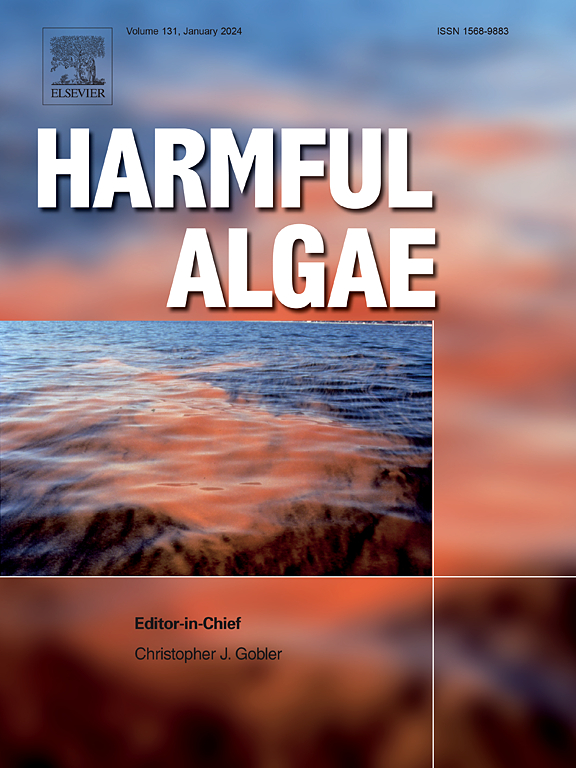Higher sensitivity of microcystin-producing Microcystis to two algaecides compared to co-cultured non-microcystin producers
IF 5.5
1区 生物学
Q1 MARINE & FRESHWATER BIOLOGY
引用次数: 0
Abstract
Targeting and selectivity are essential for assessing the effectiveness of ecofriendly algaecides in controlling toxic cyanobacterial blooms. The dose- and time-dependent effects of hydrogen peroxide (H2O2), pyrogallol and their sustained-release microcapsules (HRM, PRM) on proportion of MC-producing cell numbers and genotypes of the co-existing MC- and non-MC-producing Microcystis, as well as microcystins (MCs) concentrations were investigated in the present study. Two MC-producing and two non-MC-producing Microcystis strains were used in mono- and co-culture test systems. The findings revealed that the MC-producing Microcystis strains were more sensitive to both forms of H2O2 and pyrogallol in comparison with the non-MC-producing strains. Inhibition of all Microcystis strains by H2O2 and pyrogallol was found to be dose- and time-dependent, with H2O2 exhibiting stronger effects. Additionally, both pure and granular forms of H2O2 and pyrogallol reduced the relative abundance of MC-producing genotypes in co-culture conditions, along with total MC concentrations. The HRM and PRM demonstrated more potent and prolonged effects than their pure forms, indicating they are optimal for targeted reduction of Microcystis bloom toxicity. Their long-term effects against different levels of MC-producing Microcystis in various environmental conditions need further investigation through large-scale outdoor experiments.
产生微囊藻毒素的微囊藻对两种杀藻剂的敏感性高于共培养的非微囊藻毒素产生者
靶向性和选择性是评估生态杀菌剂在控制有毒蓝藻华中的有效性所必需的。本研究考察了过氧化氢(H2O2)、邻苯三酚及其缓释微胶囊(HRM、PRM)对共存的产MC和不产MC微囊藻产MC细胞比例、基因型以及微囊藻毒素(MCs)浓度的剂量依赖性和时间依赖性。两种产mc和两种不产mc的微囊藻菌株分别用于单培养和共培养试验系统。结果表明,产mc的微囊藻菌株比不产mc的菌株对H2O2和邻苯三酚更敏感。H2O2和邻苯三酚对所有微囊藻菌株的抑制作用均存在剂量和时间依赖性,其中H2O2的抑制作用更强。此外,在共培养条件下,纯形式和颗粒形式的H2O2和邻苯三酚都降低了MC产生基因型的相对丰度,以及总MC浓度。HRM和PRM表现出比其纯形式更有效和持久的效果,表明它们是靶向减少微囊藻华毒性的最佳选择。它们对不同环境条件下不同水平产mc微囊藻的长期影响还需要通过大规模的室外实验进一步研究。
本文章由计算机程序翻译,如有差异,请以英文原文为准。
求助全文
约1分钟内获得全文
求助全文
来源期刊

Harmful Algae
生物-海洋与淡水生物学
CiteScore
12.50
自引率
15.20%
发文量
122
审稿时长
7.5 months
期刊介绍:
This journal provides a forum to promote knowledge of harmful microalgae and macroalgae, including cyanobacteria, as well as monitoring, management and control of these organisms.
 求助内容:
求助内容: 应助结果提醒方式:
应助结果提醒方式:


